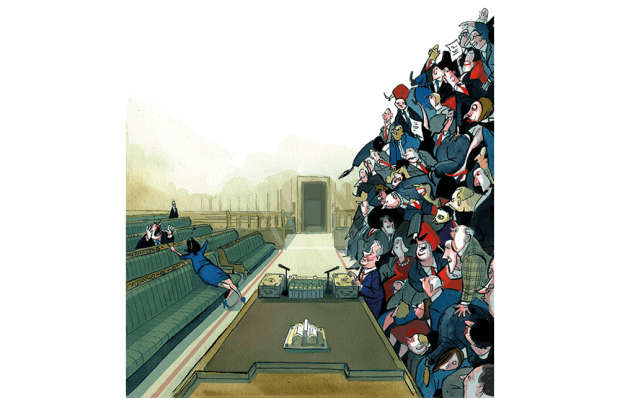The Union in peril
Sir: Fraser Nelson (‘The great pretender’, 15 May) writes that it has never been easier to make a bold positive case for the Union. He suggests the UK government starts to fight. Perhaps the starting point could be the benefits which flowed from 1707 — joint citizenship, a currency union, a customs union and wealth transfer — both individual and national (the Barnett dividend speaks for itself). Without the Union these would not have happened. Without the Union there is no guarantee any of these will continue. It is not Project Fear to point that out.
The sooner Scots begin to understand that retaining UK citizenship, the Barnett dividend and the security of having their state and public sector pensions paid in sterling will all be put in peril (and almost certainly lost) by ‘independence’, the better. These are the points which must be hammered home. If they are, support for ‘independence’ will fall, the SNP will not dare to press a referendum and Sturgeon will realise the game is a bogey and go off to do something else while she can.
Kenneth Ross
Auchencairn, Castle Douglas
Scotland’s future allies
Sir: Fraser Nelson’s analysis of the Scottish referendum debate has much to recommend it for the short-term tactical scenario. However, in the longer term there are more alarming factors to consider. The general view is that the Scottish economy will fail and the country will be condemned to poverty. Where will Scotland turn to then? Since Scotland currently does not meet the criteria for membership of the EU, and is unlikely to in the future, the most likely saviour will be Russia, possibly aided also by China. Energy, broadband, phone systems, vaccinations and military arms are commodities that are likely to be offered on favourable terms. How long before England’s indifference will turn to grave concern at the prospect of these new neighbours on our shores?
Bob Arnold
Crowborough, East Sussex
Gen Z handwriting
Sir: Mary Wakefield is right to lament the decline in handwriting in recent years (‘The writing’s on the wall’, 15 May), but I would like to reassure her that it will not die out entirely; at least not if I can help it. I am 18, so firmly Gen Z, yet I am snobbish about fountain-pen nibs. During lockdown I began written correspondence with friends, and we have discovered the excitement of recognising each other’s script on the envelope. I aspire to be a writer but I do not own a laptop: my bedroom is stacked with exercise books full of handwritten attempts at novels. I fear that my generation will leave no tangible traces behind and so, while I hold no illusions that my traces, whether letters or fiction, will ever be worth anything much to anyone, rest assured that the loops and the curls, the channels and ridges of ink on the page are enough to make me keep hand-writing them anyway.
Eleanor Clark
Devon
Beautiful bricks
Sir: Laura Freeman’s passionate lament for genuine brick buildings rather than sham brick facades (‘Affronted’, 8 May) was both entertaining and thought-provoking. In this love letter to the noble art of brick, she mentions the Pepys Library at Magdalene College, Cambridge, as a classic example of ‘fur-coat-no-knickers’ architecture, with a beautiful brick facade and nothing substantial underneath.
Well, I have good news for Laura. The brand-new, multi-million-pound Magdalene College Library, next to Pepys, features no fewer than 300,000 handmade bricks, in a dazzling array of shapes and sizes, made by the York Handmade Brick Company. The new library is a stunning testament to the beauty of brickwork and a reminder that brick is the material of choice for many of today’s most imaginative architects. Brick is back — and, having reinvented itself for the modern age, it is here to stay. Even the Shard, a love letter to glass, features impressive brickwork at its base, while the magnificent new London Bridge Station nearby derives its fresh and arresting beauty from its reliance on brick.
Robert Beaumont
Minskip, near York
China’s progress
Sir: Professor Latham notes China’s population challenges (Letters, 15 May). The Chinese Communist party killed at least two million Chinese in the Revolution, 40 million in the Great Leap Forward, and another two million in the Cultural Revolution. It may be, however, that the most serious state-sponsored catastrophe inflicted by the CCP was its one-child policy. For the last two generations, almost every Chinese child born has been a singleton. No brothers or sisters, no cousins, nieces and nephews; the abolition of family. No one has ever tried that on humans before and the effect on the birthrate is unsurprising. It may turn out that the CCP itself has wrecked China’s progress.
Peter Lucey
Wokingham, Berks
Keep noodling
Sir: As a blues harp (harmonica) player of some longevity, I was intrigued by Jeremy Clarke’s valiant attempts with this beguiling instrument (Low life, 8 May). The art is to get a single note from a hole about 4mm wide with a standard-sized human mouth, and then to bend the note in a bluesy manner. Tuition is of limited value at first, as there is nothing to see. My only advice is to keep noodling, as far from humanity as possible, until suddenly a coherent three-note phrase emerges. I remember to this day when it happened for me in 1967. So just suck it and see, Jeremy. Take your time. Blues harmonica takes an afternoon to learn and a lifetime to master.
Phil Jackson (of Jaxhill blues group)
Lichfield, Staffordshire
Got something to add? Join the discussion and comment below.
Get 10 issues for just $10
Subscribe to The Spectator Australia today for the next 10 magazine issues, plus full online access, for just $10.
You might disagree with half of it, but you’ll enjoy reading all of it. Try your first month for free, then just $2 a week for the remainder of your first year.














Comments
Don't miss out
Join the conversation with other Spectator Australia readers. Subscribe to leave a comment.
SUBSCRIBEAlready a subscriber? Log in